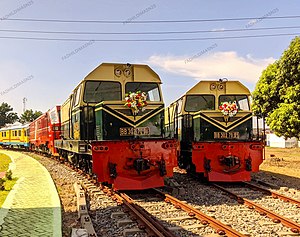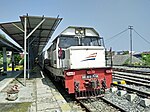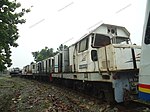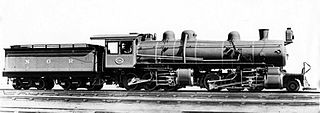
Under the Whyte notation for the classification of steam locomotives by wheel arrangement, 2-6-6-0 is a locomotive with one pair of unpowered leading wheels, followed by two sets of three pairs of powered driving wheels and no trailing wheels. The wheel arrangement was principally used on Mallet-type articulated locomotives. Some tank locomotive examples were also built, for which various suffixes to indicate the type of tank would be added to the wheel arrangement, for example 2-6-6-0T for an engine with side-tanks.

The majority of Indonesia's railways are on Java, used for both passenger and freight transport. There are three noncontinuous railway networks in Sumatra while two new networks are being developed in Kalimantan and Sulawesi. Indonesia has finalized its plan for a national railway network recently. According to the plan, 3,200 km of train tracks will crisscross the islands of Sumatra, Java, Kalimantan, and Sulawesi. It has been touted as the most extensive railway project in Indonesia since its independence from the Dutch in 1945. Indonesia targets to extend the national railway network to 10,524 kilometres by 2030. As of September 2022, the network spans 7,032 km.

In Whyte notation for the classification of steam locomotives by wheel arrangement, an 0-4-4-2 is a locomotive that has no leading wheels, two sets of four driving wheels and two trailing wheels.

PT Kereta Api Indonesia (Persero) (lit. 'Indonesian Railways (State-owned) Limited', abbreviated as PT KAI or simply KAI) is a major railway operator in Indonesia and one of the public railway companies in the country. It is state-owned and pays track access charges. Its headquarters are located in Bandung, West Java. In 2019, KAI carried 429 million passengers and 47.2 million tonnes of cargo.

The DF4 is a type of diesel-electric locomotive used in the People's Republic of China. It has been in production since 1969 and is still produced as of 2007 by several local companies. It is the most common locomotive in China and is used for both passenger and freight services.

The Ambarawa Railway Museum is a museum located in Ambarawa in Central Java, Indonesia. The museum preserves around 21 steam locomotives and focuses on tourism train tours hauled by 3 operational steam engines and a hydraulic diesel engine, using the remains of the closing of the 3 ft 6 in (1,067 mm) railway line.

The GE U20C diesel-electric locomotive was introduced by GE Transportation Systems as an export model in 1964. It was powered by the 8-cylinder 7FDL-8 engine. This locomotive is used worldwide with many variations and modifications. Different engines may be used, e.g. 7FDL8 and 7FDL12. Like the other members of the Universal series, it can be built to suit all track gauges.

Medan Station (MDN) is the main railway station in Medan, North Sumatra, Indonesia. In addition to intercity services operated by Indonesia's national rail operator, Kereta Api Indonesia, the station also has service to Kualanamu International Airport via Kualanamu ARS.
PT Industri Kereta Api (Persero), abbreviated as INKA, is an Indonesian state-owned rolling stock manufacturer.
The Tasikmalaya derailment occurred on 4 April 2014 at 18:30 local time when the passenger train "Malabar", with 250 passengers on board, was derailed by a landslide in Kadipaten, Tasikmalaya Regency, West Java. The accident killed 5 people and another 35 were injured. Heavy rain triggered the landslide, which derailed the train as it traveled through Java, the most populous island in Indonesia.
Most railway lines in Indonesia were constructed during the Dutch colonial rule. After independence in 1945, many lines were abandoned. The current national rail operator, PT Kereta Api Indonesia (Persero), was founded on 28 September 1945.

The GE CM20EMP diesel-electric locomotives are owned by Kereta Api Indonesia and built by GE Transportation. The GE CM20EMPs are multipurpose locomotives, not only for hauling passenger trains, but also freight trains.

The Argo Jati was a train service operated by Kereta Api Indonesia between Jakarta and Cirebon in Java, Indonesia. This train was relaunched on November 3, 2010, as a replacement train series of Argo Jati, which was launched in 2007.

Sri Lelawangsa is a commuter rail service in Indonesia operated by KAI Bandara, serving Medan Station to Kuala Bingai Station route and vice versa. The service began operation on 6 March 2010 using Kereta Rel Diesel Indonesia (KRDI) DMU by INKA. But now the Sri Lelawangsa train series has changed to a Local Economy Class train pulled by locomotive BB302, BB303 or BB203.
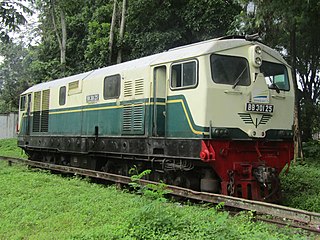
The BB301 is a class of 50 diesel-hydraulic locomotives built by Krupp and Krauss-Maffei in West Germany for the then Indonesian State Railway (PNKA). The locomotive first entered service in 1964.

On 5 January 2024, two trains collided near Cicalengka Station in Bandung Regency, Indonesia, killing four rail employees and injuring 42 others.

The SS 1600 class, later redesignated as the CC50 class, is a 2-6-6-0 articulated Mallet type steam locomotive previously operated by the Staatsspoorwegen (SS), which was built by Werkspoor and the Swiss Locomotive and Machine Works (SLM).
